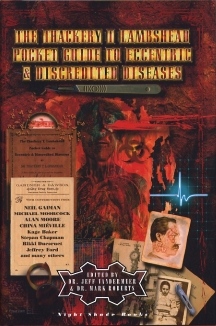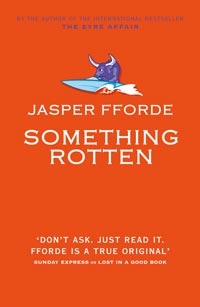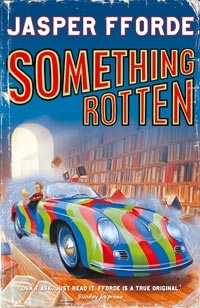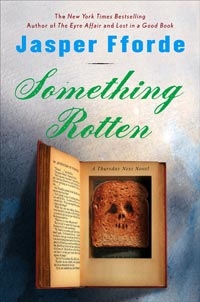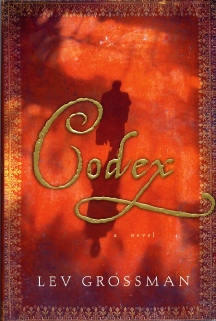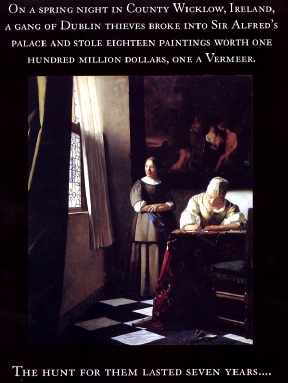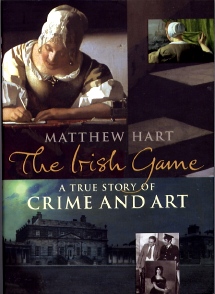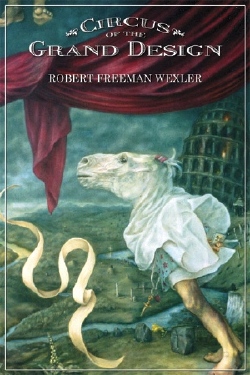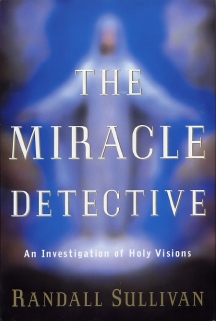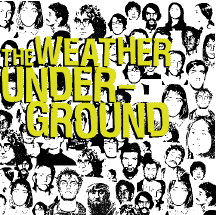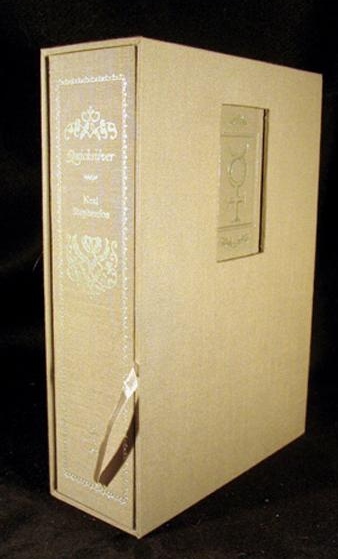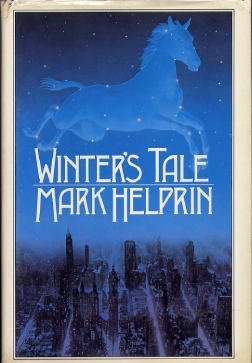|
|
|
This Just in..News from the Agony Column
|
04-30-04: Fforde in Sync, Lambshead Reading Live on KUSP |
|||||||||
The Razornail Radio Show
|
|||||||||
Jasper Fforde's Triple Threat: Something is Definitely Not Rotten
Something is definitely not rotten as far as I'm concerned. Now, you can learn just about everything you're about to read here at Fforde's website. But I'm here to make it easy for you, and see that you get the best in book covers and coverage. TN4 finds Thursday back in Swindon and Goliath threatening to change to a faith-based corporate management system. Do you need to know any more? I don't. Fforde's been on the auto-buy list from practically day one. Having these books released in sync is a huge improvement. I know that Terry Pratchett was happy to have it happen for him, and I'm sure Fforde will be happy as well. However, if his US publishers think their sales will increase significantly, I suspect they may be in for a surprise. Fforde is the kind of author who inspires intense dedication, and I bet a pretty significant percentage of his readers are buying all the hardcover editions. But it will certainly make it easier for customers on both sides of the pond to get in sync and keep in sync.
But in addition to this collector's edition, which is sure to fetch a fair bit of change, there's the "UK NEW LOOK B Format hardcover. Now me, I like this look as well. We're told that eventually all the TN books will have this "30's pulp feel". I'm just wondering if they'll pre-scuff the jacket, or if the scuffing will be built into the duplication process. But let me make this clear -- I expect a scuffed look, period! And finally, the US books, which go for a sort of classy, literary, silly and surreal feel and pretty much nail it. I can actually understand why US publishers didn't want to go with the original design of the books from H&S in the UK, as it is so Ukish that US buyers would definitely wonder what the hell was up with the book. And to be honest, the literary look of the US editions is pretty damn sweet.
I'd better include room for a cot. |
|
04-29-04: The Critic Codex |
|||
Time Magazine Critic Lev Grossman Mixes Rare Books with Common Computer Games
Then I'd look at the cover and think of agent Kimberley Cameron, telling those of us at Left Coast Crime about the "25 or so 'Da Vinci Code' rip-offs" that she gets daily. And then I put the book down again. Intrigued and embarrassed, not necessarily a potent buying blend of emotions. Eventually it showed up over at KUSP -- two, count 'em two copies, and I was able to take a longer look at this book. Fact of the matter is that intrigued wins out over embarrassed. Grossman's book is clearly no DVC rip-off, and in it he appears to combine some very interesting elements. Edward Wozny, a hotshot banker, is asked to uncrate and sell a box of old books for a valued bank client. Initially annoyed, he becomes intrigued when he learns that the crate may contain a codex, a treasure hidden away for many years. Wozny enlists the help of a [presumably hot, young] medieval scholar to help him unravel the history and message of the codex. At the same time, he finds himself increasingly addicted to a computer game that has many parallels in the codex. While it sounds like 'The Da Vinci Code' in many respects (ancient manuscripts, modern thrills), I read an NYT review of it that suggested it had a lot in common with Borges as well as Lara Croft. A quick check on the author finds that he's a critic for Time Magazine and has written for Salon, The New York Times (Oh -- OK) and others that suggests he should be able to put something together more interesting than a slick summer thriller. In fact, this sounds a bit like 'Cryptonomicon', which is an entirely different league than DVC. And I might add that Ms. Cameron did not suggest that they were publishing lots of DVC rip-offs. Furthermore, it's interesting to note that myself -- and I suspect, the readers of this column -- manage an almost instantaneous reaction to to DVC-alikeness of this novel's production: dislike. So if they're trying to sell it as a DVC-like novel, they're re actually driving down the readers. In retrospect, ready to read, I don't think that's the case. Given that books have a two year or so back log through the system, this novel was still a-borning when DVC was climbing the charts. So, if you've picked this up a few times, pick it up again. At some point, you might not put it down. |
|
04-28-04: The Irish Game: Steal This Painting, Buy This Book |
|||||
Matthew Hart Follows the Vermeer
True crime titles tend to be on the trashy side, because the true crimes that really grab our interest are the seediest -- and because the publishers presume that only the seedy are buying these books. While that's usually the case it isn’t always the case. Witness this title about the theft of a Vermeer by a discerning Dublin rogue named Martin Cahill. In 1986, Cahill and his accomplices stole a Vermeer as well as works by Gainesborough, Goya and Rubens. But they found they couldn't actually sell the paintings so they used them as collateral in drug deals. That's only one of the things that Hart uncovers in his book. They also discovered how Vermeer created his paintings when they examined the work for damage.
Hart focuses on the personalities behind the theft and comes up with a great set of characters, more than worthy of your novel reading instincts. Martin Cahill, a gentleman gangster who liked to wear Mickey Mouse shirts, was also known as The General. Rose Dugdale was a British heiress, a graduate of Oxford with a PhD from London University and a political activist. Myles Connor, Jr., was an early rock and roller who opened for Sha Na Na and called himself The President of Rock. All of these threads are tied together in Hart's work. Now look -- what more do you need? A rock guitarist, a British heiress and a Dublin gangster; I don't think it gets any better than that. As long as you're not an art collector. |
|
04-27-04: Writers Online: Robert Wexler Interview at Fantastic Metropolis and Jay Lake at Fictionwise, Randall Sullivan, PI: The Miracle Detective |
||||||
Wexler Speaks and Lake Writes
Wexler's forthcoming novel, 'Circus of the Grand Design', another essential title from Prime Books, offers some more of the same mixture of the ordinary and the unusual that makes his work so enjoyable. I'm not sure if you enjoy circus books like me -- 'The Circus of Doctor Lao' and 'Quin's Shanghai Circus' are among my favorites -- but even if the circus gives you the creeps -- or perhaps especially if the circus gives you the creeps --then you'll want to pre-order this book.
|
||||||
From
Oregon to Bosnia-Herzegovina on the Trail of the Blessed Virgin Mary
The book had its genesis in 1994, when a young woman in Oregon experienced a vision of the Blessed Virgin Mary. Sullivan, an Oregon resident himself, set out to understand something that's long interested me; that is, how the Catholic Church and the Vatican investigate these matters and confirm or deny them. That's one of the reasons I so enjoy the Merrily Watkins novels of Phil Rickman; Rickman is the first writer to create the "spiritual procedural" covering precisely such investigations in the Anglican Church. Sullivan's journey might have started with a simple look into how the Vatican was working in the ground in his home turf, but as such quests do, it ballooned into an eight-year investigation into predictions of Apocalypse, divine manifestations and false claims of revelation. He started out as a profound skeptic and came away changed. In the interim, he journeyed to Medjugoroje in Bosnia-Herzegovina, and Scottsdale Arizona, some of the biggest scenes of BVM activity in the last half of the last century. For me, the interest in BVM apparitions is two-fold; as s supernatural event they are curiously positive and revelatory, as opposed to ghosts, and other evils that creep in the dark. But most importantly, to me they excavate the psyche of a community with a clarity that no reality can achieve. They are a way of seeing ourselves that gets directly to the heart of how we live and why we live, how we hope and how we fear. All that all the speculative fiction in the world can aspire to comes to life in these visions. Be alert; subscribe to news services and file the clippings. There's a pattern that will emerge. It seems to be that it might be at least fascinating, flawed and human, but at most vitally important.
|
|
04-26-04: The Weather Underground on PBS, Neal Stephenson Limited Editions, A Winter's Tale Comes Home |
|||||
A
Nation that Will Never Be Again: The Weather Underground on PBS
While I in general don't feel that movies offer as worthwhile an investment for your time as books, there are some exceptions and this documentary is one of them. Offering a time, a place and a cast of characters that are unforgettable and utterly real, 'The Weather Underground' turns your head around about how things have gone in this country.
|
|||||
Not
First But Best: Neal Stephenson Limited Editions from Wm Morrow
The usual practice when it comes to limited editions is to have the small press publishing partner publish the limited editions first. That brings them value on two levels; they're both limited and first editions. That's why they're not a bad buy for the investor and collector, and marginally more justifiable purchases for the simply compulsive. The first editions of Stephenson's masterwork thus far -- I say this because Stephenson's young yet and may have a couple comparably epic works in the wings -- are those books you bought at the bookstore last year and this year. If you were lucky enough, you got an autographed edition; at least I did courtesy my local independent bookstore. Those were the books that came out first, that makes them the first editions, end of story. Ask a certain small-press publisher who was skunked when a certain large press publisher in a certain country moved up their publication date for a very popular title, leaving said small press publisher high and dry. It doesn't matter how deluxe, how beauteous the edition is, if it comes out after another less beauteous edition, it's still not a first. So, the truly compulsive who are going to be buying the limited edition of QuickSilver are those who to a one, I predict, will have already bought and in most cases read the title long before they see the delivery of their new literary baby. But what a baby. If you're going to shell out $200 plus delivery on a book, it had better have; [quoting from the website]:
Six-month intervals? Who are they kidding? Since, if I'm not mistaken,
the first batch is already late [the given date for publication is
06-01-2004] (I can't be sure if that's late, though), the prospects for the
rest being "on-time" are not great. But who cares?
We're (yes I'm signed up via Ziesing) not in this for the reading.
We're in
this for the re-reading. That's right. Somewhere in a golden future
we plan on having lots of time to read. |
|||||
Mark
Helprin, Beer & Fruit Loops
But seeing that copy on the shelves was a stroke of luck, the kind of luck that infuses the pages of the novel itself. It's an early example of what would come to be called 'magic realism', a novel that was critically acclaimed at the time but has since, I believe, unfairly fallen out of favor when compared with the work of the also excellent John Crowley. Still, it's a prime example of the emotional hold that books have over you. 20 years ago I was making plans to get married, and we'd just barely recovered from our 1984 New Years Eve party. I was working at a blood factory, and for the party I'd nabbed 20 antiseptic full-body suits. We had bowls of breakfast cereal -- Fruit Loops and Trix -- in addition to potato chips, and when things got out of control, the guests hurled the cereal on other guests who were rolling on the floor in their antiseptic suits, covered in beer and smeared colored cereal. After the party, when everyone went home, it was almost dawn, and the skunks that lived under our suburban Spanish bungalow in Redondo Beach started mating. They made these hideous screeching squeaks that rose from the floor-heater furnace vents. In frustration my wife-to-be and I jumped up and down on the grates to quiet the skunks. It might be that our judgment was impaired at the time. The result was that two skunk let loose in the basement under the center of our house and drove us out on the front porch to watch dawn. Orwell's year to fear had arrived and we couldn't go inside out house without our eyes watering. Somewhere in that house was -- or would soon be -- a paperback copy of 'Winter's Tale'. It was -- and is -- the kind of book that hangs out in the memory, like a floor smeared with beer-Fruit Loop paste in a house reeking of skunk. |
